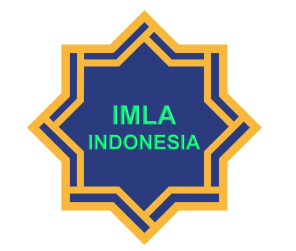The Implementation of the Mimicry Memorization Method in Arabic Vocabulary Learning at MI Takhassus Darul Ulum
DOI:
https://doi.org/10.21580/alsina.6.1.23362Keywords:
Arabic vocabulary, learning method, mimicry memorizationAbstract
This study aims to describe the application of the mimicry memorization method in teaching Arabic vocabulary, analyze its implementation based on its inherent characteristics, and identify the strengths and weaknesses of this method in the context of Arabic vocabulary learning among fifth-grade students at Madrasah Ibtidaiyah (MI) Takhassus Darul ʿUlum Ngaliyan, Semarang. Employing a qualitative descriptive approach through fieldwork, the research utilized data collection techniques including observation, interviews, and documentation. Data analysis followed the Miles and Huberman model, comprising data reduction, data display, and conclusion drawing. Findings reveal that the mimicry memorization method at MI Takhassus Darul ʿUlum involves processes of listening, pronouncing, imitating, and memorizing vocabulary. Its strengths include direct skill acquisition by students, accurate and proper pronunciation, ease and enthusiasm in memorizing vocabulary, improved understanding of vocabulary material, increased student engagement, and enhanced recall of vocabulary. The weaknesses identified are limited learning time during memorization, reduced student attention to the teacher’s pronunciation in noisy classroom settings, and a lack of diverse media resources.
Downloads
References
Afandi, Muhamad et al. Model dan Metode Pembelajaran di Sekolah. 1st ed. Semarang: UNISSULA PRESS, 2013.
Ahmadi, and Aulia Mustika Ilmiani. Metodologi Pembelajaran Bahasa Arab Konvensional Hingga Era Digital. 1st ed. Yogyakarta: RUAS MEDIA, 2020.
Andani, Sylvi Tri, and Dewi Anggraini. “Tingkat Penguasaan Kosakata Bidang Lingkungan oleh Siswa Tingkat SMP.” Jurnal Bahasa dan Sastra 11, no. 1 (2023): 27–33. https://doi.org/10.24036/jbs.v11i1.122294.
Ansori, Choirul, and Nur Hasaniyah. Bahasa Arab : Kelas 5 Madrasah Ibtidaiyah (MI). 1st ed. Bogor: Yudhistira, 2020.
Arif, Muh. “Metode Langsung (Direct Method) dalam Pembelajaran Bahasa Arab.” Al-Lisan Jurnal Bahasa dan Pengajaranya 4, no. 1 (2019): 44–56. https://doi.org/10.30603/al.v4i1.605.
Christison, MaryAnn, and Denise E. Murray. “Professional Learning through Professional Development for Second Language Teachers.” In Handbook of Practical Second Language Teaching and Learning, edited by Eli Hinkel. New York: Routledge, 2022.
Dixon Jr., Wallace E., and Brenda J. Salley. “‘Shhh! We’re Tryin’’ to Concentrate": Attention and Environmental Distracters in Novel Word Learning.’” The Journal of Genetic Psychology 167, no. 4 (2007): 393–414. https://doi.org/10.3200/GNTP.167.4.393-414.
Hasyem, Syarifuddin. “Keefektifan Pembelajaran Mufradat untuk Meningkatkan Kemahiran Berbicara Bahasa Arab Santri Daya di Kota Banda Aceh.” Jurnal LISANUNA 5, no. 1 (2019): 144–55. https://doi.org/10.22373/l.v5i1.860.
Huang, Min et al. “EFL Learners’ Engagement in Different Activities of Blended Learning Environment.” Asian-Pacific Journal of Second and Foreign Language Education 7 (2022): 9. https://doi.org/10.1186/s40862-022-00136-7.
Kasprowicz, Rowena E. et al. “Investigating Distribution of Practice Effects for the Learning of Foreign Language Verb Morphology in the Young Learner Classroom.” The Modern Language Journal 103, no. 3 (2019): 580–606. https://doi.org/10.1111/modl.12586.
Koderi, Koderi et al. “Implementasi Strategi Mimicrymemorization pada Pembelajaran Mufradat Bahasa Arab bagi Siswa Madrasah Ibtidaiyahmin 7 Bandar Lampung.” Al-Fathin: Jurnal Bahasa dan Sastra Arab 4, no. 1 (2021): 49–61. https://doi.org/10.32332/al-fathin.v4i01.3448.
Kustina, Kiki et al. “The Intercultural Aspect of Teaching Arabic as a Foreign Language in Indonesia.” Mantiqu Tayr: Journal of Arabic Language 4, no. 1 (2024): 279–93. https://doi.org/10.25217/mantiqutayr.v4i1.4086.
Larsen-Freeman, Diane. Techniques and Principles in Language Teaching. 3rd ed. Oxford: Oxford University Press, 2013.
Li, Zhongmin, and Andrew-Peter Lian. “Achieving Self-Imitation for English Intonation Learning: The Role of Corrective Feedback.” Chinese Journal of Applied Linguistics 45, no. 1 (2022): 106–25. https://doi.org/10.1515/CJAL-2022-0108.
Loewen, Shawn et al. “The Effectiveness of App‐Based Language Instruction for Developing Receptive Linguistic Knowledge and Oral Communicative Ability.” Foreign Language Annals 53, no. 2 (2020): 209–33. https://doi.org/10.1111/flan.12454.
Mahdi, Dawood Ahmed. “Improving Speaking and Presentation Skills through Interactive Multimedia Environment for Non-Native Speakers of English.” Sage Open 12, no. 1 (2022). https://doi.org/10.1177/21582440221079811.
Marissa, Kiki Riska. “Analisis Metode Mim-Mem (Mimicry-Memorization) pada Pembelajaran Bahasa Arab di Madrasah Tsanawiyah Negeri 4 Tanjung Jabung Timur.” Jurnal Pendidikan Bahasa Arab dan Budaya Islam 3, no. 1 (2022): 59–67. https://online-journal.unja.ac.id/Ad-Dhuha/article/view/19418.
Miavara, Hifni Mevin et al. “Penggunaan Metode Mimicry Memorization dalam Penguasaan Mufradat Siswa Kelas VIII B SMP Muhammadiyah Haurgeulis.” PUSTAKA: Jurnal Bahasa dan Pendidikan 2, no. 4 (2022): 102–13. https://doi.org/10.56910/pustaka.v2i4.190.
Nasution, Novita Sari, and Lahmuddin Lubis. “Urgensi Pembelajaran Bahasa Arab dalam Pendidikan Islam.” Jurnal Simki Pedagogia 6, no. 1 (2023): 181–91. https://doi.org/10.47783/jurpendigu.v2i2.232.
Nation, Ian Stephen Paul. Learning Vocabulary in Another Language. Cambridge: Cambridge University Press, 2001. https://doi.org/10.1017/CBO9781139524759.
Perez, Maribel Montero. “Second or Foreign Language Learning through Watching Audio-Visual Input and the Role of on-Screen Text.” Language Teaching 55, no. 2 (2022): 163–92. https://doi.org/10.1017/S0261444821000501.
Richards, Jack C., and Theodore S. Rodgers. Approaches and Methods in Language Teaching. Cambridge: Cambridge University Press, 2014. https://doi.org/10.1017/9781009024532.
Rosalinda, Rosalinda. “Penguasaan Mufradat (Kosakata) Bahasa Arab dengan Menggunakan Metode Mimicry Memorization (Mim-Mem Method).” Serambi Konstruktivis 4, no. 1 (2022): 103–15. https://doi.org/10.32672/konstruktivis.v4i1.4319.
Ruane, Janet M., and M. Shodiq Mustika. “Penelitian Lapangan; Saksikan dan Pelajari: Seri Dasar-Dasar Metode Penelitian.” In Essentials of Research Method : a guide to social science reserach, 1st ed., 1–97. Jakarta: Nusa Media, 2021.
Shintani, Natsuko. “Repeating Input-Based Tasks with Young Beginner Learners.” RELC Journal 43, no. 1 (2012): 39–51. https://doi.org/10.1177/0033688212439322.
Sidiq, Umar, and Moh. Miftachul Khoiri. Metode Penelitian Kualitatif di Bidang Pendidikan. Ponorogo: Nata Karya, 2019.
Sugiyono. Metode Penelitian Kuantitatif, Kualitatif dan R&D. Bandung: Alfabeta, 2016.
Sulistyawati. Buku Ajar Metode Penelitian Kualitatif. 1st ed. Yogyakarta: K-Media, 2023.
Susanto, Nurwin et al. “Pembelajaran Mufradat Bahasa Arab Menggunakan Metode Mimicry Memorization pada Siswa Kelas VA MI Al-Muna Samarinda.” Borneo Journal of Language and Education 2, no. 1 (2021): 214–26. https://doi.org/10.21093/benjole.v1i2.5487.
Tim PAI MI. Husna: Bahasa Arab Madrasah Ibtidaiyah Kelas 3. Boyolali: Warna Mukti Grafika, 2020.
Tsany, Hafizhah Arrova et al. “Analisis Pola Interaksi Wacana Kelas dalam Pembelajaran Bahasa Arab di Sekolah Dasar.” Jurnal Pendidikan dan Pembelajaran Indonesia (JPPI) 4, no. 2 (2024): 556–71. https://doi.org/10.53299/jppi.v4i2.549.
Wigglesworth, Gillian, and Cathie Elder. “An Investigation of the Effectiveness and Validity of Planning Time in Speaking Test Tasks.” Language Assessment Quarterly 7, no. 1 (2010): 1–24. https://doi.org/10.1080/15434300903031779.
Zhou, Xiao. “Creative Imitation: An Answer to the Fundamental Issue of L2 Learning.” Chinese Journal of Applied Linguistics 44, no. 3 (2021): 351–65. https://doi.org/10.1515/CJAL-2021-0022.
Downloads
Published
How to Cite
Issue
Section
License
Copyright (c) 2024 Alsina : Journal of Arabic Studies

This work is licensed under a Creative Commons Attribution-NonCommercial-ShareAlike 4.0 International License.
Copyright
The copyright of the received article shall be assigned to the publisher of the journal. The intended copyright includes the right to publish the article in various forms (including reprints). The journal maintains the publishing rights to published articles. Authors are allowed to use their articles for any legal purposes deemed necessary without written permission from the journal, but with an acknowledgment to this journal of initial publication.
Licensing
In order for Alsina: Journal of Arabic Studies to publish and distribute research articles, the editors need publishing rights (transferred from author to publisher). This agreement relates to the transfer/publishing copyright license to Alsina: Journal of Arabic Studies but the authors still have significant rights to use and share their published articles.
Alsina: Journal of Arabic Studies supports the need for writers to share, disseminate and maximize the impact of their research and their rights on any database. As a journal article writer, you have the right to various uses of your articles, including that by the institution or company where you work. Copyright can be used without the need for special permission. Authors who publish articles in the Alsina: Journal of Arabic Studies have broad rights to use their work for teaching and scientific purposes without requesting permission, including:
- Use by the author for lectures, presentations, or conferences, with distribution of copies to participants;
- Distribution to colleagues for research use;
- Use in compilations of the author's subsequent work;
- inclusion in a thesis or dissertation;
- Reuse of sections or excerpts from articles in other works (with full acknowledgment of the final article);
- Preparation of derivative works (other than commercial purposes) (with full acknowledgment of the final article);
- Voluntary posting on open websites operated by authors’ or writers' agencies for scientific purposes
When submitting a manuscript, authors do so on the understanding that if accepted for publication, the copyright for publishing (publishing right) of the article shall be assigned/transferred to Alsina: Journal of Arabic Studies.
Authors whose articles are accepted for publication will receive confirmation via email and sent a Copyright Transfer Agreement.

 Accreditation
Accreditation 
 In Collaboration with
In Collaboration with 

 Visitors
Visitors  Article Template
Article Template





